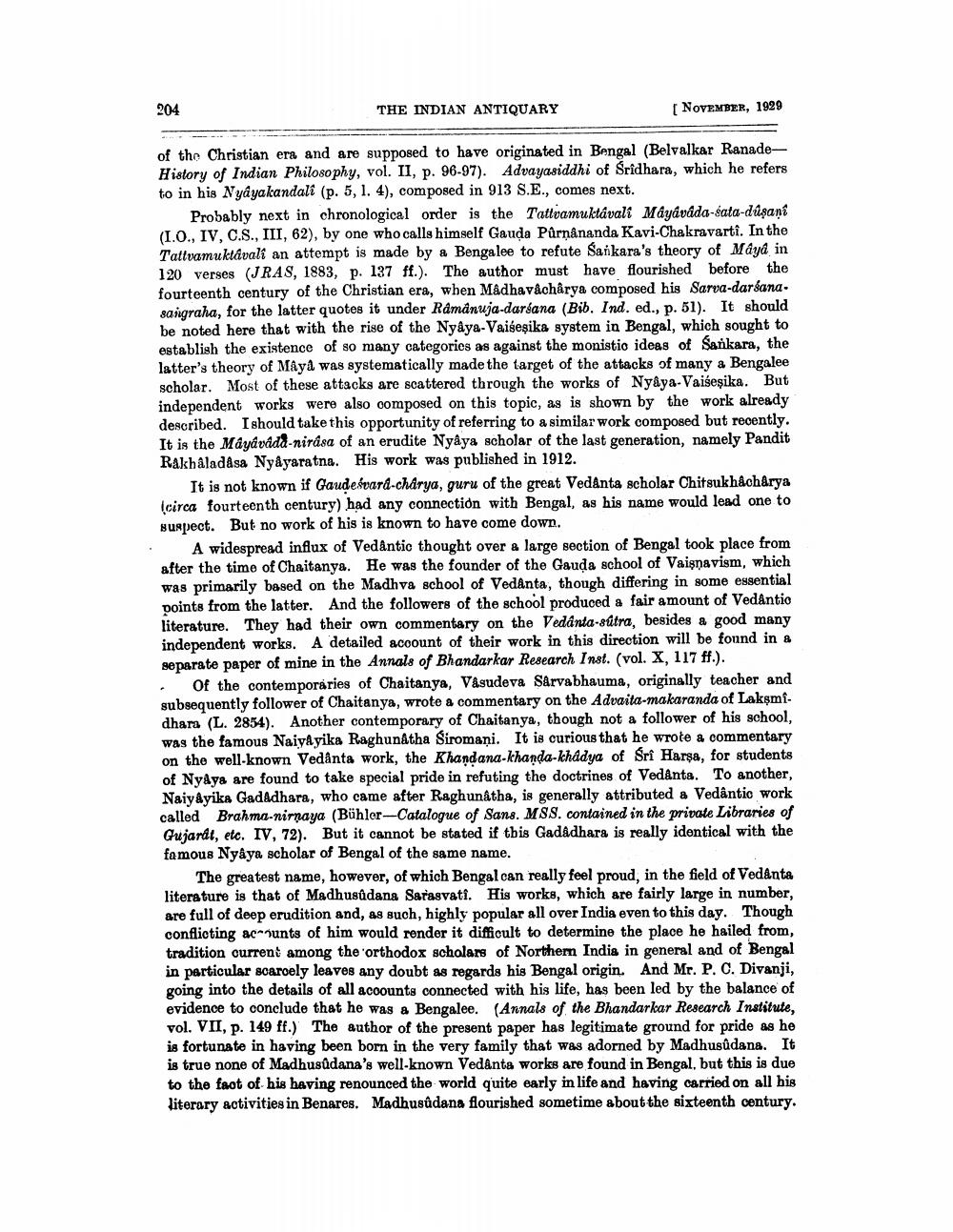________________
204
THE INDIAN ANTIQUARY
NOVEMBER, 1929
of the Christian era and are supposed to have originated in Bengal (Belvalkar RanadeHistory of Indian Philosophy, vol. II, p. 96-97). Advayasiddhi of Sridhara, which he refers to in his Nyâyakandali (p. 5, 1. 4), composed in 913 S.E., comes next.
Probably next in chronological order is the Tattvamuktavalt Mayavada-sata-důşani (1.0., IV, C.S., III, 62), by one who calls himself Gauda Pärnananda Kavi-Chakravarti. In the Tattvamuktavali an attempt is made by a Bengalee to refute Sankara's theory of Máyá in 120 verses (JRAS, 1883, p. 137 ff.). The author must have flourished before the fourteenth century of the Christian era, when Madhavacharya composed his Sarva-darsana. sangraha, for the latter quotes it under Ramanuja-darsana (Bib. Ind. ed., p. 51). It should be noted here that with the rise of the Nyâya-Vaigesika system in Bengal, which sought to establish the existence of so many categories as against the monistio ideas of Sankara, the latter's theory of Maya was systematically made the target of the attacks of many a Bengalee scholar. Most of these attacks are scattered through the works of Nyâya-Vai eşika. But independent works were also composed on this topic, as is shown by the work already described. I should take this opportunity of referring to a similar work composed but recently. It is the Mayavadda-nirása of an erudite Nyâya scholar of the last generation, namely Pandit Rakhaladása Nyâyaratna. His work was published in 1912.
It is not known if Gaudešvard-charya, guru of the great Vedanta scholar Chitsukhácharya (circa fourteenth century) had any connection with Bengal, as his name would lead one to suspect. But no work of his is known to have come down.
A widespread influx of Vedântic thought over a large section of Bengal took place from after the time of Chaitanya. He was the founder of the Gauda school of Vaişnavism, which was primarily based on the Madhva school of VedAnta, though differing in some essential points from the latter. And the followers of the school produced a fair amount of Vedântio literature. They had their own commentary on the Vedanta-adtra, besides a good many independent works. A detailed acoount of their work in this direction will be found in & separate paper of mine in the Annals of Bhandarkar Research Inst. (vol. X, 117 ff.). . Of the contemporaries of Chaitanya, Vasudeva Sarvabhauma, originally teacher and subsequently follower of Chaitanya, wrote a commentary on the Advaita-makaranda of Lakşmidhara (L. 2854). Another contemporary of Chaitanya, though not a follower of his school, was the famous NaiyAyika Raghunatha Siromani. It is curious that he wrote a commentary on the well-known Vedanta work, the Khandana-khanda-khadya of Sri Harsa, for students of Nydya are found to take special pride in refuting the doctrines of VedAnta. To another, NaiyAyika GadAdhara, who came after Raghunatha, is generally attributed a Vedântic work called Brahma-nirnaya (Bühler-Catalogue of Sans. MSS. contained in the private Libraries of Gujardt, etc. IV, 72). But it cannot be stated if this Gadadhara is really identical with the famous Nyâya scholar of Bengal of the same name.
The greatest name, however, of which Bengal can really feel proud, in the field of Vedanta literature is that of Madhusudana Sarasvati. His works, which are fairly large in number, are full of deep erudition and, as such, highly popular all over India even to this day. Though conflicting acmounts of him would render it difficult to determine the place he hailed from, tradition current among the orthodox scholars of Northern India in general and of Bengal in particular scarcely leaves any doubt as regards his Bengal origin. And Mr. P. C. Divanji, going into the details of all acoounts connected with his life, has been led by the balance of evidence to conclude that he was a Bengalee. (Annals of the Bhandarkar Research Institute, vol. VII, p. 149 ff.) The author of the present paper has legitimate ground for pride as he is fortunate in having been born in the very family that was adorned by Madhusudana. It is true none of Madhusûdana's well-known Vedanta works are found in Bengal, but this is due to the faot of his having renounced the world quite early in life and having carried on all his literary activities in Benares. Madhusudana flourished sometime about the sixteenth century.




